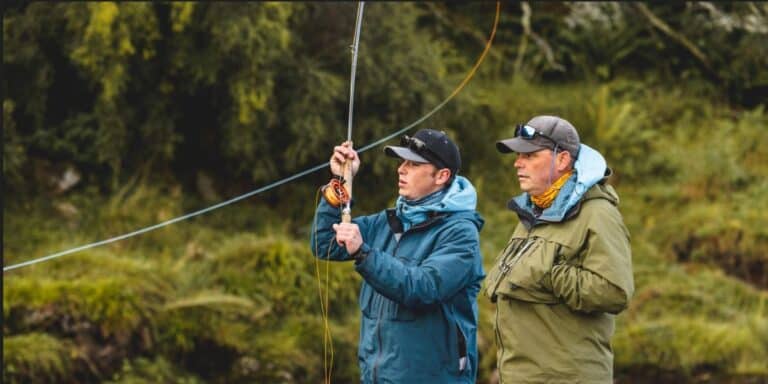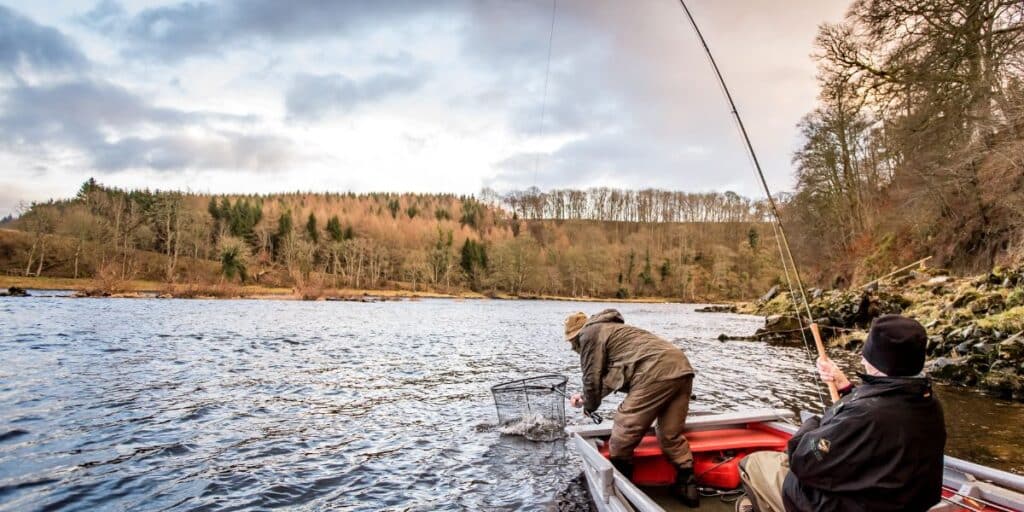Trout fishing is a popular sport and Scotland is the ideal destination for anglers due to its stunning landscapes, abundant rivers and lochs, and the variety of trout species found.
Species of trout in Scotland
Brown trout, rainbow trout, sea trout, and brook trout are to be found in Scotland. The most prevalent and extensively dispersed species in Scotland, brown trout, can be found in practically all rivers and lochs. While sea trout travel from the sea to freshwater to reproduce, rainbow trout are mainly found in Stillwater fisheries. Less frequent brook trout are found in a few of Scotland’s smaller rivers and streams.
Scotland’s Top Trout Fishing Spots
Scotland is well known for having stunning fishing locations.
The River Tay is the largest river in Scotland and a breeding ground for some of the largest brown trout to be found in Scotland. There are many beautiful spots along the river, from where to cast.
Large and shallow Lake Leven is well-known for its brown trout fishing. The loch has breathtaking views and is encircled by stunning mountains.
One of Scotland’s most famous salmon rivers is the River Tweed, which also has outstanding trout fishing. Large brown trout and sea trout are particularly prevalent in the river.
In Argyll and Bute, there is a deep freshwater loch called Loch Awe. The loch provides fantastic fishing opportunities and is home to brown trout, rainbow trout, and pike.
Seasons for fishing for trout in Scotland
Scotland offers year-round trout fishing, but the spring and summer seasons are the most productive. Getting trout to your fly during the summer is easier since they are more active in the warmer waters.
Rules for fishing for trout in Scotland
Before you begin trout fishing in Scotland, you must educate yourself on the rules. The Scottish Government controls fishing in Scotland, and tight regulations govern the size and quantity of trout you are allowed to capture. Before you begin fishing, double-check the rules and ensure you have the required permits and licences.
Scotland Trout Fishing Gear and Equipment
You will want a few essential tools and supplies for trout fishing in Scotland. This comprises:
Rod: The best rod for Scottish trout fishing is a 9-foot, 5- or 6-weight rod.
Reel: To successfully land giant trout, you need a dependable revolution with a smooth drag system.
The best line for trout fishing in Scotland is a floating line.
Most Scottish trout fishing scenarios call for a 9-foot leader with a 4X or 5X tippet.
Waders and Boots: While fishing in Scotland’s rivers and lochs, a decent set of waders and boots will keep you dry and comfortable.
Fly Box: For effective trout fishing in Scotland, you must have a well-stocked fly box with a range of patterns.
Polarised sunglasses can help you see through the lake’s glare, making it simpler to find trout and avoid potential dangers.
Scottish Trout Fishing Methods
Different fishing methods are used for trout in Scotland depending on the region and circumstances. Here are some techniques to experiment with:
Dry fly fishing is a well-liked method of catching trout in Scotland. A fly is displayed on the water’s surface to mimic a natural bug.
Nymph fishing involves using a small, weighted fly resembling a larva or nymph to catch fish underwater.
Fishing using a more giant, more noticeable fly that resembles a baitfish or other small prey is known as streamer fishing.
Tenkara Fishing: Tenkara fishing is a form of fly fishing that originated in Japan and is currently gaining popularity in Scotland. This entails fishing for trout with a short, lightweight pole and a primary line.
Scottish trout fishing’s top flies
For Scottish trout fishing to be successful, selecting the appropriate fly is crucial. The following are some of the top flies for fishing for trout in Scotland:
Dry Flies: For trout fishing in Scotland, Adams, Blue Winged Olives, and Caddisflies are all good choices.
Hare’s Ear, Pheasant Tail, and Diawl Bach are good nymphs to use when fishing for trout in Scotland.
Woolly Buggers, Zonkers, and Muddler Minnows are reliable streamers for Scottish trout fishing.
Scottish Fly Tying for Trout Fishing
In Scotland, the ability to tie flies is crucial for trout fishing. Making your own flies allows you to save money and develop patterns specific to your area’s fishing conditions. In Scotland, some well-liked fly patterns for trout fishing include:
A traditional Scottish fly pattern, the Kate McLaren, imitates various insects and small prey.
Clan Chief: This adaptable fly pattern can be used as a nymph, wet fly, or dry fly when fishing.
In addition to mayflies and caddisflies, the Dunkeld is a classic Scottish fly pattern that imitates various prey.
Scottish Trout Fishing Casting Methods
For Scottish trout fishing to be successful, proper casting technique is necessary. The following advice can help you develop your casting technique:
Consistent practice can help you build muscle memory and increase the accuracy of your casting.
Employ the correct grip: You can cast farther and more accurately using the proper grip.
Use the right time: You may cast smoothly and accurately with the right timing.
Advice for Scottish Trout Fishing Success
Here are some more pointers for Scottish trout fishing success:
Be mindful of the weather and the state of the water.
Use flies that mimic the local insects and prey to match the hatch.
To prevent startling the fish, practise stealth and patience.
Try out several methods and flies to determine which ones suit the fishing conditions where you are.
Scotland’s Trout Fishing Guides
A local fishing guide might be a terrific choice if you’re new to trout fishing or want to discover new fishing spots in Scotland. In addition to helping, you locate the best fishing areas, fishing guides can offer expert advice on the circumstances and methods of the local fishing industry. In Scotland, some well-liked trout fishing guides are:
Scotland accommodations for trout fishing
For those who enjoy trout fishing, Scotland has a variety of lodging alternatives, including hotels, self-catering cottages, and fishing lodges. Popular choices comprise:
The Atholl Arms Hotel is a welcoming lodging option with convenient access to the River Garry in the centre of Blair Atholl.
The Lake of Menteith Hotel offers breathtaking views and convenient access to some of Scotland’s top trout fishing areas. It is situated on the banks of Lake of Menteith.
On the banks of Loch Ness is a luxurious self-catering facility called The Highland Club. Some of Scotland’s top trout fishing spots are close to the complex.
- FAQs
Is a fishing licence required in Scotland to catch trout?
No, you do not need a fishing licence in Scotland. However, you must have the legal right or permission from the landowner or fishery owner to fish for trout. This usually means buying a permit from an angling club, fishery, or estate. - What time of year is ideal for Scottish trout fishing?
The spring and summer months, from April to September, are ideal for trout fishing in Scotland. - What distinguishes brown trout from rainbow trout?
Scottish brown trout are a biological species found in rivers and lochs. Rainbow trout are primarily found in Stillwater fisheries and are not native to Scotland. - What is the best fly to use in Scotland when fishing for trout?
Different flies are best for trout fishing in Scotland, depending on the area and the fishing circumstances. The Hare’s Ear, the Pheasant Tail, and the Woolly Bugger are well-known fly patterns. - May I hire a fishing guide in Scotland to take me trout fishing?
Scotland has several fishing guides who offer guided tours for trout fishing in some of the top fishing spots in the nation. - What equipment do I need to fish for trout in Scotland?
A rod, reel, line, leader, and tippet are necessary items for trout fishing in Scotland, along with waders, boots, a fly box, and polarised sunglasses. - What trout fishing methods work best in Scotland?
In Scotland, fly fishing methods that are effective for trout include dry fly, nymph, streamer, and tenkara fishing. - In Scotland, am I allowed to tie my flies for trout fishing?
Indeed, fly tying is a necessary skill for trout fishing in Scotland, and making your flies allows you to cut costs and design patterns specific to the fishing conditions where you live. - Where in Scotland are the most incredible spots for trout fishing?
The River Tay, Loch Leven, River Tweed, and Loch Awe are a few of Scotland’s top trout fishing locales. - Can I catch trout all year long in Scotland?
Indeed, you may fish for trout all year long in Scotland, but the finest seasons are in the spring and summer. Before you begin fishing, reviewing the seasons and fishing laws is vital. The Scottish Government controls fishing in Scotland, and tight regulations govern the size and quantity of trout you are allowed to capture. Before you begin fishing, double-check the rules and ensure you have the required permits and licences. - What qualities need to a Scottish trout fishing guide have?
Choose a Scottish trout fishing guide who knows the area and has previous experience fishing there. Verify customer feedback and reviews and confirm the guide’s insurance and licence status. - In Scotland, is it possible to fish for species than trout?
Yes, Scotland has a range of options for fishing for species other than trout, such as salmon, pike, and sea trout. - How much does a fishing guide in Scotland cost to hire?
Depending on the guide, the area, and the trip duration, many factors affect the cost of hiring a fishing guide in Scotland. Before hiring a guide, it’s crucial to do some research and compare pricing. - Is Scottish trout fishing appropriate for novices?
Indeed, beginners can enjoy trout fishing in Scotland, and several spots and guides specialise in this activity. It’s crucial to begin with, the fundamentals and gradually hone your technique.
Anglers of all skill levels can enjoy a unique and gratifying experience while trout fishing in Scotland. You may improve your chances of success and maximise the enjoyment of your upcoming fishing trip in Scotland by learning about the many trout species, the best locations to fish, the gear and equipment required, and the tactics and fly to employ.
Always check the fishing restrictions before you start fishing, and ensure you have the required permits and licences; it’s crucial to remember this. Hiring a guide is also a terrific option for novice anglers or those seeking to discover new fishing grounds.
In conclusion, anglers can enjoy a distinctive and thrilling experience while trout fishing in Scotland. Scotland has gained popularity among anglers worldwide due to its stunning scenery and variety of trout species.
It would be best to do homework on the various species and their habitats, the finest fishing spots, and the required gear and equipment to maximise your trout fishing trip in Scotland. Also, knowing the seasons and fishing laws will assist in guaranteeing a fruitful and fun fishing expedition.
Scotland offers much to novice anglers, including supervised excursions and accessible fishing spots. And for seasoned fishermen, Scotland has some of the world’s most challenging and rewarding trout fishing opportunities.
While fishing in Scotland, keep in mind to always respect the environment and adhere to the Leave No Trace philosophy. This entails cleaning up and leaving the fishing spot in the same state you found it.
Hence, whether you’re an experienced or novice angler, trout fishing in Scotland is a memorable experience. Scotland offers some of the best fishing possibilities in the world thanks to its breathtaking landscapes, numerous trout species, and vibrant fishing culture.



